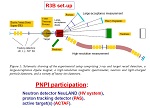|
NuSTAR project R3B experiment at GSI.
 PNPI Group Leader: G.D. Alkhazov
PNPI Group Leader: G.D. Alkhazov
PNPI physicists participate in the R3B experiment of the NuSTAR project at the FAIR accelerator complex. The purpose of the R3B experiment is to
study the properties of exotic nuclei, i.e. nuclei with an abnormal ratio of the number of protons and neutrons. The study of such nuclei has
recently become one of the main areas of research in physics of the atomic nucleus. Thanks to the more intense primary beams of the accelerated nuclei
than previously, as well as due to a new super-separator of nuclear fragments with a large acceptance angle and its higher resolution,
as well as thanks to the unique experimental facilities to be used in experiments conducted here, the NuSTAR collaboration will reach the most
advanced positions in the world in the study of exotic nuclei and nuclear reactions at intermediate energies.
PNPI physicists are actively involved in the creation of one of the main systems of the experimental R3B installation - the time-of-flight neutron
detector NeuLAND, namely, in the development and fabrication of the high-voltage power supply system for photomultiplier tubes of the NeuLAND detector.
In 2020, the work on the creation of the high-voltage NeuLAND detector system for 6000 channels was completed. All the work was done solely
by PNPI physicists. In the future, it is planned to maintain the operability of the created high-voltage system and to participate
in R3B experiments using the NeuLAND detector. PNPI physicists also carry out work on modeling of the response of the spectrometer for various particles.
They participate in testing of the photomultipliers and in the assembling of the NeuLAND detector.
(For more details see the presentation
"PNPI in R3B"..)
The PANDA Experiment.
 PNPI group leader O.V. Miklukho
PNPI group leader O.V. Miklukho
High-precision measurements of the proton-antiproton annihilation and antiproton-nucleus
scattering will be performed in the planned PANDA experiment. The antiproton beam with 1.5÷15 GeV/c momenta and fractional uncertainty
of 5·10-5÷10-4 will be created at the constructed
accelerator HESR at GSI (Darmstadt, Germany). The project luminosity will be 2·1031÷2·1032 ñì-2 s-1.
The masses of produced at PANDA experiment resonances will be measured with precision
of about 100 KeV. A few thousands of the c-anti-c pairs will be detected per day. This permits
to study with high precision charmed hadrons and particles with hidden charm. The line form of
the produced system will be studied with a very high precision. Glueballs, exotic mesons,
strange baryons with the strangeness equal to -1, -2, and -3 and hypernuclei with these baryons
will be investigated in the many-purpose experiment PANDA. The nucleon form factor in the
time-like region will also be studied.
The PANDA detector will have practically 4? acceptance, high resolution of the charged
particle tracks and perfect particle identification. It consists of many subsystems. The PNPI
Few Body System Laboratory is creating the time-of-flight detector of the forward particle
having vertical and horizontal angles 5 and 10 degrees, respectively. Detector will consist of 56
plates made from the EJ-200 scintillator with the vertical and horizontal dimensions of 140 cm
and 10 cm, respectively, and plates width is 2.5 cm. Every plate is controlled by two end-cap
Hamamatsu photomultipliers R13435. The planned time resolution of the detector will be better
than 100 picoseconds which permits to resolve reliably protons, charged pions, kaons and their
antiparticles
Detailed description of the PANDA experiment and the time-of-flight detector can be found
at the site of the Few Body System Laboratory in the section
«Current projects and recent results»,
(see file
«References.pdf»).

|